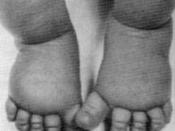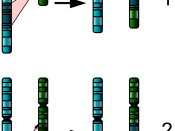In 1938 Dr. Henry Turner, an internist at the
University of Oklahoma, described what is now called
Turner's syndrome. Turner's syndrome is a relatively
common genetic disorder found in females affecting many
body systems. Although this disorder was described in
1938, it was not until 1959 that the technology was
available to determine the cause of this disorder.
Humans normally have a total of 46 chromosomes (which
are tiny, DNA-containing elements) that are present in
every cell of the body. DNA encodes genes, which specify
all the proteins that make up the body and control its
functions. There are 23 matched pairs of chromosomes in
every cell. Each cell contains 22 pairs of chromosomes
called autosomes that are the same in males and females.
The remaining pair of chromosomes, the X- and Y-
chromosomes, are not shaped similarly, and thus are not
matched in the same way as the autosomes.
The X- and Y-
chromosomes are called sex chromosomes. They are
responsible for the difference in development between males
and females. A Y-chromosome contains genes responsible for
testis development; and the presence of an X-chromosome
paired with a Y-chromosome will determine male development.
A female with normal genetic make-up has two X-chromosomes
in each of her cells, one which she received from her
father and one, which she received from her mother. Two X-
chromosomes are required for normal ovarian development in
females
The female with Turner's syndrome has only one X-
chromosome in each of her cells due to a nondisjunction
event during meiosis of her parents' gametes. A careful
examination of the genetic material, usually by means of a
blood sample, can confirm the diagnosis of Turner's
Syndrome. Depending on the degree of nondisjunction of her
parents' gametes, the genotype of Turner Syndrome can
vary. The...


